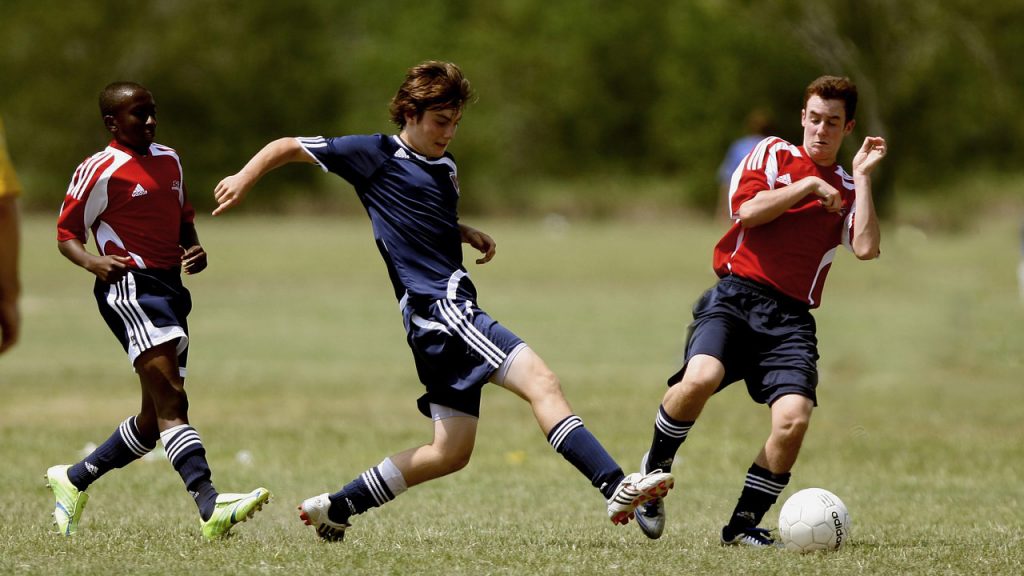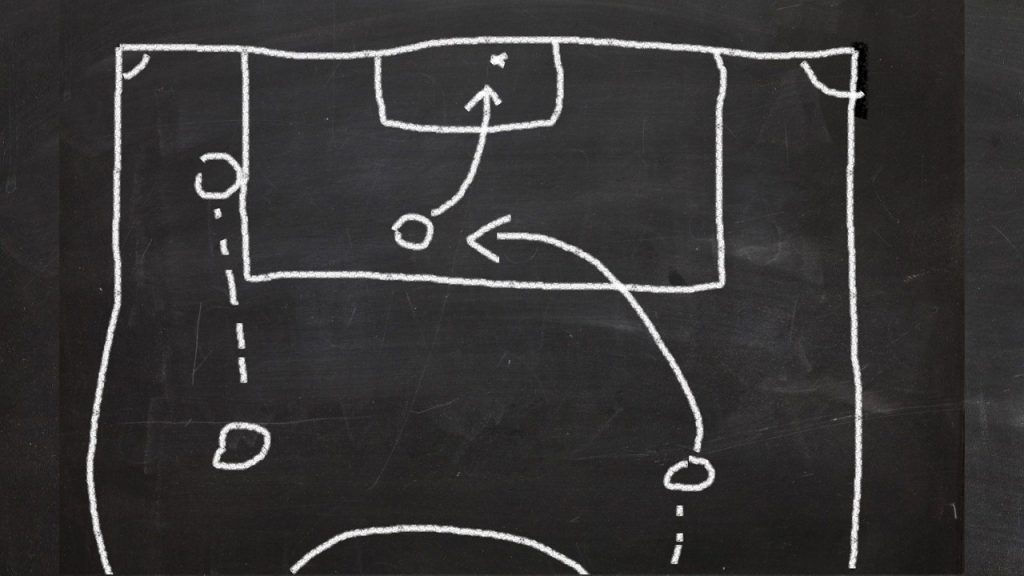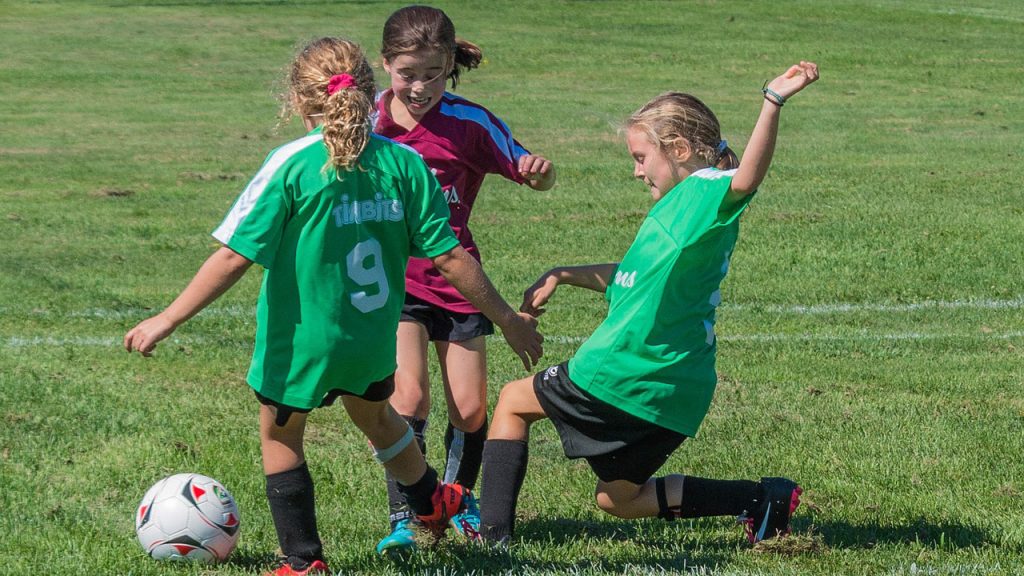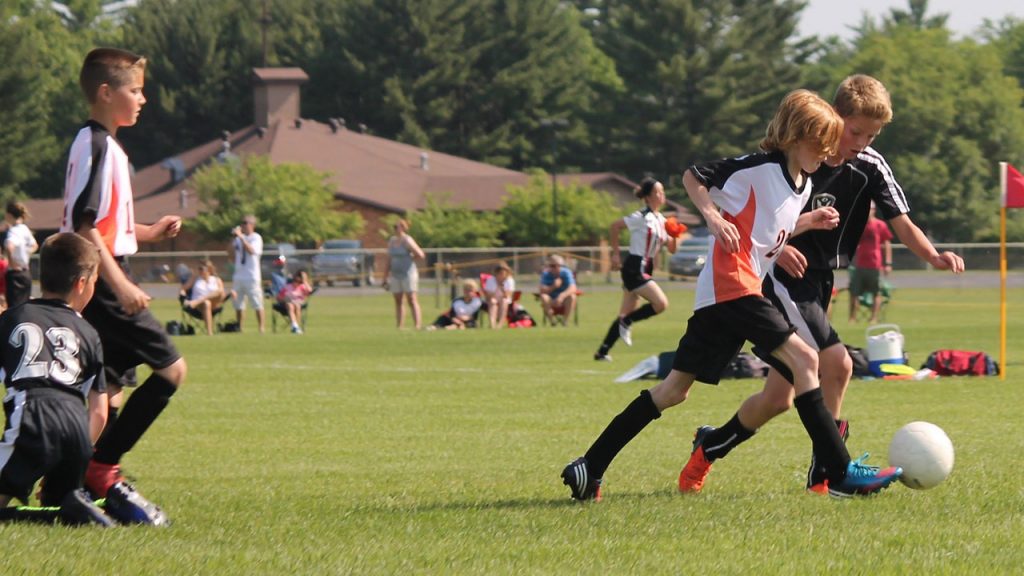Authority Soccer (authoritysoccer.com) is a participant in the Amazon Services LLC Associates Program, an affiliate advertising program designed to provide a means for sites to earn advertising fees by advertising and linking to Amazon.com. This site also participates in other affiliate programs and is compensated for referring traffic and business to them.
Playing soccer is an excellent way to have some fun with friends while also taking care of your health. However, finding 21 other people to play with can be a difficult task, especially during winter.
This is why 3v3 soccer has quickly turned out to be the fastest-growing form of soccer in the world.
3v3 soccer is played between two teams, both of which can only have three players on the field at a time. The field used for 3v3 soccer is smaller than the standard pitch, and it typically stands at 30 yards wide by 30 yards long.
Smaller goals are also used than in standard soccer games, and typically there’s no keeper; whoever reaches the goal first can defend the goal without using their arms.
Playing soccer 3v3 is not only suitable for amateurs who gather once a week to have some fun, but it can be an excellent way for professionals, and those who aspire to become professional, players to improve their game.
In this article, we will discuss the strategies, tactics, and drills that are aimed at improving your 3v3 game, as well as share some of the best tips for this type of play. Enjoy the reading!
3 v 3 Soccer Strategy

As fun as this way of indulging in soccer is, there’s a strategic aspect to the 3v3 play.
In the first section of this text, we’ll share some of the most commonly used 3v3 soccer strategies, for both offense and defense, explain when they should or should not be applied, as well as share the ways you can beat them.
1. Defensive 3v3 soccer strategies
Before we jump into some of the most commonly used defensive 3v3 soccer strategies, remember that using just a single strategy throughout the entire game is never recommended; mix and match is the key.
1. Bumble Bee Defense
This is one of the commonly applied defensive strategies among beginner 3v3 soccer players. It is based on everyone blindly running after the ball and it is never effective nor recommended.
To beat this so-called strategy, all that the attacking team needs to do is keep passing the ball until they have an opportunity to score.
2. Planted Player Defense
This defensive style is used to prevent goals and it is based on one of the players staying steady as a plant at their own goal.
While significantly reducing the chance of scoring, this defensive strategy can lead to some counterattack chances, which is why it’s commonly used in 3v3 soccer.
This defensive style can be beaten by not forcing long shots and taking shots that are unlikely to lead to a counterattack.
3. Front Line Defense
The front-line defense strategy is not an actual defensive strategy; this playstyle pushes all of the team’s players forward in order to score more goals, leaving their own goal exposed.
Playing the front-line defense is only recommended in cases when your team is significantly ahead or significantly behind and you have nothing to lose.
2. Offensive 3v3 soccer strategies
The same thing we’ve mentioned with the defensive strategies also applies to offense: Mix and match for optimum results. With that said, let’s take a look at the most popular 3v3 soccer offense strategies:
1. Hog Ball Offense
Another strategy applied by 3v3 soccer beginners, hog ball offense is when a single player holds the ball and tries to dribble and score without passing to open teammates.
This offensive style is only recommended when all of your teammates are covered and in 1v1 situations. Hog-ball offense is also the only situation when the bumblebee defense works.
2. Counterstrike Offense
This offensive strategy is based on the defense obtaining the ball and sending it down the field towards the opponent’s goal and/or an open teammate.
Counterstrikes are how the majority of goals in 3v3 soccer are scored. This offense is prevented with a planted player defense or fast defensive players.
3. One-Touch Offense
The one-touch offense is another commonly used offensive style in 3v3 soccer; players don’t hold the ball, but rather keep passing it until they’ve reached the opponent’s goal.
This playstyle is interrupted by defenders going after the ball instead of waiting for it to reach one of the opposing team’s players.
After going through some of the most commonly used 3v3 soccer strategies, we hope that it’s clear which ones can be applied in specific situations and which you should avoid.
Best tactics and formations for 3 v 3 soccer

Even though it might seem slightly unnecessary as there’s not much to do with just three players on the pitch, a tactical approach to 3v3 soccer is something that has evolved into a science in its own right.
Tactics and formations have been a topic of discussion among enthusiasts for years, and here are some of the best ones you can apply to your team’s play:
1. Playing the 1-1-1 formation
The 1-1-1 formation is the most commonly used formation in 3v3 soccer. You might think that it doesn’t matter which player goes where, as there are only three of them, but you’d be wrong:
This formation is based on the tactic that the team’s best player is placed in the middle of the field, as they can then help both in offensive and defensive play.
This manner of playing places the team’s fastest and most aggressive player up front where they can score.
This leaves us with the fullback position which should be reserved for the team’s strongest player who can stop the opposing team’s attack and isn’t afraid to block shots with his/her own body.
Admittedly, building a team that consists of all three types of athletes is no easy task, but employing this tactic has been proven to provide the best and most consistent results.
2. Playing the V formation
The V formation is another popular way of playing 3v3 soccer. This formation is based on two players standing in the front of the field, while one sticks back to defend, forming the letter V.
Employing this tactic has shown excellent results on the goal-scoring end of the game. In addition, with one player always staying behind, the V formation basically eliminates the risk of counterattack.
This tactic and formation should be used when you’re certain in all of the players’ abilities to perform their roles; you must be sure that the two attackers can score, and you must be certain that the defender can handle 1v2 or even 1v3 situations.
3. Playing the A formation
Opposite to the previous 3v3 soccer tactic on the list, the A formation is based on having two defenders and a single attacker.
This type of play is avoided in most cases, especially by amateur players. The one case you’d want to bring it out is when your team is ahead and you want to defend your goal.
In professional and more serious amateur 3v3 soccer, the A formation is used when the team is certain that their single attacker can handle the opposing team’s defense and score in 1v2 or 1v3 situations.
4. Playing with adaptive tactics and formations
Sometimes the best thing you can do is let go of the formal tactics and formations and focus on playing the game. 3v3 soccer is, despite the low number of players involved, a game that can be played in a million different ways.
Just because your team agreed to go with a certain formation and specific tactics doesn’t mean that all conditions for the plays you had in mind will be met.
Learning to adapt the tactics and formations as the game progresses is one of the first things that newcomers to the game of 3v3 soccer learn, most commonly the hard way.
After going through some of the most commonly used 3v3 soccer formations, what’s left to say is that teams around the world most commonly use the 1-1-1 formation, which is the one that we recommend for those who are newcomers to the small-sided game.
That is until they learn to adapt their tactics to the opposing team’s and apply the last piece of tactical advice from this section.
3 v 3 Soccer Tips

You can disregard all of the strategic development, drills, and advanced knowledge of 3v3 soccer if you haven’t covered the basics. This is why we’ve decided to share 10 tips that cover the basic principles of 3v3 soccer.
1. Work on 1v1 skills
Playing soccer 3v3 in a professional, semi-professional, or even amateur environment is famous for requiring more skill than regular soccer.
Individual skills, such as touch, are essential in this game; if the basic aspects of the game, such as receiving and controlling the ball, aren’t done with no thinking and hesitation, the players lose valuable time and almost certainly any chance of winning.
Perfecting one’s touch and controlling the ball with confidence is what separates good 3v3 players from the average and bad ones.
2. Don’t hold on to the ball
Hogging the ball is never the right call unless you’re in a 1v1 situation with no one to pass the ball to. This tip can be applied to the situations we encounter in the offense as well as in defense.
There’s one commonly mentioned tip for regular soccer defense that is more than suitable for 3v3 soccer: When in doubt, kick it out.
3. Avoid shots from the corner
Shooting or crossing from the opponent’s corner is never a good thing; in most cases, it leads to intercepted balls that turn into a 3v2 scenario that goes in favor of your opponent.
4. Don’t stop playing until you hear the whistle
This is another tip that originates from regular, 11v11, soccer: Just because you saw a foul doesn’t mean you should stop playing the ball.
A foul is only a foul when the referee’s whistle blows. Don’t risk being on the receiving end of a goal because of it.
5. Run back as soon as you lose the ball
Losing the ball is inevitable in 3v3 soccer, regardless of how good your ball-handling skills are.
One thing to keep in mind is, never stay upfront when you lose the ball unless the team’s previous agreement and strategy specifically say so.
6. Forwards should stay closer to the middle during the kick-off
Here’s one of the most basic tips you can receive on 3v3 soccer play: Never stand wide when the opposing team kicks off as they are left with the room to easily dribble down the middle and score.
7. Are there two defenders on you? Good!
When you’re a victim of the double team defense, you must keep one thing in mind; one of your teammates is fully open.
Instead of panicking, make sure to find them and pass the ball.
8. Forwards need to stay in front of the last opponent
There’s no offside rule in 3v3 soccer, but standing behind the last opponent is never a good idea.
This way, a ball that is intended for you can be intercepted and can leave you out of position and unable to defend.
9. Don’t despair if you’re behind
Falling behind a few goals is not a big deal in 3v3 soccer. This is a fast-paced game that sees tons of goals, so it’s never too late to step up and bring your team back into the match.
10. Be aware of the official rules
This one’s important even for amateur players, but it especially refers to those who compete in 3v3 soccer tournaments.
While there are the basic rules that every 3v3 player needs to follow, each tournament or a competition, whether at your local gym or in a professional setting, can have its own set of rules.
If you’re competing, make sure that the entire team is familiar with the rules before the first match starts.
3 v 3 Soccer Drills

After going through the list of most commonly used 3v3 soccer strategies and formations, and sharing some useful tips, the only thing left to share are the best drills that you can start doing today. Here’s the list of the ones we find to be the most effective:
1. Turn and Shoot
This drill can be performed with the entire team, but it can’t function without at least two people involved. Here’s how it works:
All players are lined up, each with a ball in front of their feet, turning their backs to the coach. The coach places a cone, steps away from the field, and yells Go!
Players then turn, look for the cone, and shoot. Whoever knocks the cone down first gets a point unless their ball was the last to reach the cone. The cone can be placed anywhere on the field, including on the goal and in the net to make things more interesting.
2. Touch-Step Dribbling
For this drill, players need to dribble the ball across the field. The challenge is that they need to alternate between touching the ball forward with one foot while making a step forward with the other.
This drill is meant to replace the common issue with soccer beginners where they kick the ball and then run after it. Touching instead of kicking ensures that the ball stays close and controllable at all times.
3. Cone Race
Racing between the cones is one of the basic drills for improving the players’ handling and touch skills. Cones should be set up in a line and the players need to dribble through them.
To make things interesting, the line in which the cones are set up doesn’t have to be straight. Also, for more fun, you can add a competitive element: Two players can start at each end of the line, and whoever reaches the opposing end first wins.
4. Soccer Tennis
Thinking of the middle of the field as the tennis net, players should attempt to kick the ball across the net into the opponent’s field after it’s reached their own field and hasn’t bounced off of it more than once.
As long as the ball doesn’t touch the ground, the players are allowed to juggle in order to get into position. The drill can be performed 1v1, 2v2, or 3v3.
5. Two-touch Showdown
This drill requires two players, one ball, and three cones. The cone should be placed in a triangular shape, with around two to three feet between them.
The first player then pushed the ball through the cones to the second player. The second player then returns the ball through the cones, avoiding the path that the previous pass took.
The players are allowed two touches for the maneuver to be considered valid.
Moving from the regulation-size pitch to a small one meant for 3v3 is not an easy task, and neither is making your first-ever soccer moves on the smaller field.
Whichever is the case, applying the strategies, formation tactics, tips, and drills listed in this article, we have no doubt that anyone can become a better 3v3 soccer player.

